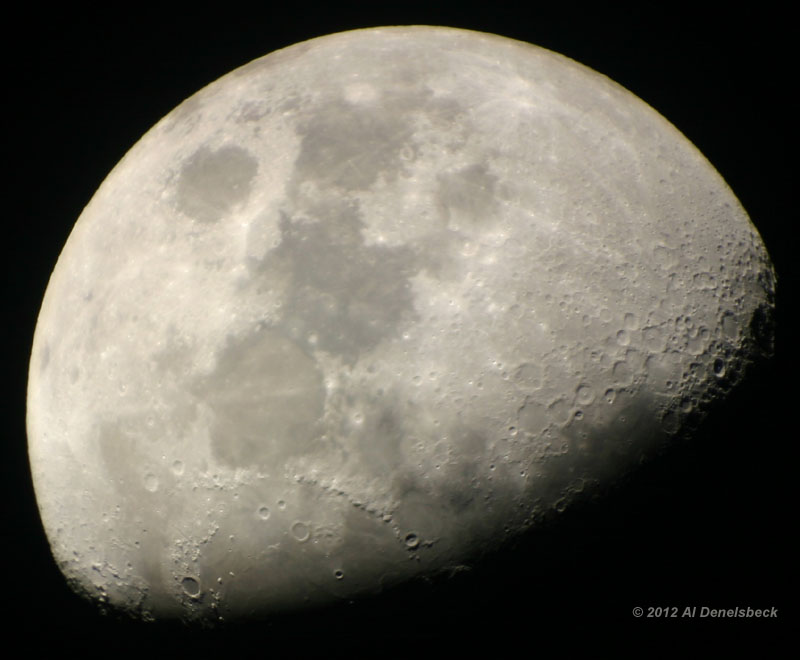8" f8 Galilean telescope
ISO 100
1/30 second
| Canon 300D 8" f8 Galilean telescope ISO 100 1/30 second |
| So close, and yet... |
|
 |
|
For a little while I possessed a halfway decent telescope, a nice 8" Galilean reflector with an alt-azimuth mount and tracking motor. The problem was, I don't really have close access to dark sky regions, and hauling the whole thing 50-200 km to set up for the evening was something that just wasn't happening. Plus, to get the images I really wanted, I would have needed some specialized filters anyway, so I finally decided to let it go.
Before that happened, however, I did try out a few photos, without the benefit of a proper camera adapter – this image was taken by holding the camera body without lens directly up to the eyepiece mount with no eyepiece. While I could potentially have achieved sharper images by doing it right, this one really isn't so bad for all that.
While most people want to photograph the full moon, it's much better to choose times when there's a distinct terminator, since oblique light throws shadows from all of the details and really accentuates the textures of the surface. It can give a great idea of the ages of the craters, for instance, because the older ones have filled in with lava flows and their sides have eroded.
Everyone, regardless, should take some time looking through a decent scope. Being there in person looking at the moons of Jupiter or the fuzz of Andromeda is far, far more exhilarating than any image will convey – they suddenly seem right there, just above our heads, real and immediate. And believe me, your local astronomy club is usually more than happy to accommodate you. Go do it!
 Now for part two. The phases of the moon all stem from what angle the moon is to the sun from our perspective, so as the moon moves towards crescent phase, it means it is visible more in the day. The new moon, otherwise known as the dark or blank moon, is actually rising and setting very close to the sun, and is up only during daylight hours. But there's this unofficial competition to see who can capture the thinnest crescent moon possible, which is challenging, because you're aiming almost into the sun and, even if you can eliminate the glare, there's still the light of the sky to deal with, and that's always brighter the closer you look towards the sun.
Now for part two. The phases of the moon all stem from what angle the moon is to the sun from our perspective, so as the moon moves towards crescent phase, it means it is visible more in the day. The new moon, otherwise known as the dark or blank moon, is actually rising and setting very close to the sun, and is up only during daylight hours. But there's this unofficial competition to see who can capture the thinnest crescent moon possible, which is challenging, because you're aiming almost into the sun and, even if you can eliminate the glare, there's still the light of the sky to deal with, and that's always brighter the closer you look towards the sun.
So one afternoon I attempted it, and believe me, knowing full well that it was there and almost exactly where to look, it still took no small amount of time to find it. I was lying on my back at the edge of the porch, with the tripod on the steps next to me with the center-column offset sideways to let the camera and 170-500mm lens hang over my face, pointing almost straight up. This was taken 1:00 pm EDT June 16th, and the new moon occurred at 11:00 am June 19th, so this was just shy of three days away. Thierry Legault has me beat by a bit, it seems, but note the lengths he went to as well.
 While I was doing this, I inadvertently found Venus too, while tracking an airplane with binoculars. Notable about this is that it's just 11 days from the transit, and already showing a distinctive crescent (that the telescope would have done a much better job of capturing.) The day probably couldn't have been much brighter, and I was using my hat to block the glare from the lens, since even a lenshood doesn't work when you're pointing within 10 degrees of the sun.
While I was doing this, I inadvertently found Venus too, while tracking an airplane with binoculars. Notable about this is that it's just 11 days from the transit, and already showing a distinctive crescent (that the telescope would have done a much better job of capturing.) The day probably couldn't have been much brighter, and I was using my hat to block the glare from the lens, since even a lenshood doesn't work when you're pointing within 10 degrees of the sun.
